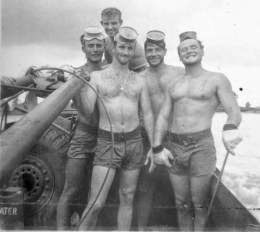The art of surfing and the art of war have long paralleled each other. In popular culture, specifically in film the two mediums have intersected to create very significant and iconic images, think Jack in Big Wednesday, Lance Johnson and Col. Kilgore in Coppola's Apocalypse Now. Though both films take place in the 1960's against the backdrop of the Vietnam War, the parallel can be traced back much further.
On November 20th 1943, the combined amphibious forces of the US Navy and the 2nd Marine Division, launched an assault on the Gilbert Island's coming ashore on the Atoll of Tarawa. Aerial reconnaissance showed the atoll surrounded by submerged reefs which the LVT'S, tracked 'Alligator' vehicles would negotiate to deliver the Marines to the beach. The tides and depths however remained a mystery as the First wave of troops passed over relatively successfully. By the time the second wave was ready the tides had dropped significantly forcing the Marines to abandon their landing craft in chest deep water a thousand yards from shore leaving them vulnerable to the elements of the sea and exposed to the heavy machine gun fire of the Japanese defenders. The resulting confusion was a disaster, hundreds were drowned others withered under a hail of bullets, the first wave already on the beach deprived of re-enforcements held on tenaciously. Miraculously and through the sacrifice of thousands of lives the Marines over a 76 hour period were able to secure the atoll and the Gilbert chain that bought them that much closer to Tokyo.
After this experience, Admiral Kelley Turner, Commander of the 5th Amphibious Force conceived the idea of an advance recon unit that could map the approach to the beaches and clear a path for the advancing Marines. He directed that 30 officers and 150 enlisted men be moved to Waimanalo ATB (on the “big island” of Hawaii) to form the beginnings of a reconnaissance and demolition group aptly called UDT, Underwater Demolition Team.
Author Craig Stecyk in his introduction for Don James's photo book, 'Surfing San Onofre to Point Dume', describes the surf population at the time of Admiral Turner's decision as being several hundred individuals spread along the shores of the United States. With WWII and the draft terminating this idyllic eden they were immersed in they began to steel themselves for the conflict ahead. Having experience around water and the open ocean, local Californian surfers like Pete Peterson and Bob Butt as well as Hawaiian waterman John Kelly, gave up their wave riding, body surfing and lobster diving to become part of the nucleus of these underwater demolition teams, forerunners of the modern elite Navy Seals, their peace time skills being case-hardened by the rigors of Combat, swimming into hostile beaches along the chain of Micronesia leading to the home islands of the rising sun.
In the summer of 1945, Fran Heath, famous Hawaiian Hot Curl rider and John Kelly served aboard the U.S.S. Calcedony and were assigned to escort and patrol duties. They bought along their boards and surfed many virgin pacific reefs such as Palmyra, the Christmas and Canton Islands and Midway, Midway being the best with a long right hand slide on the eastern side of the Island. Later in the year they were assigned to UDT duty where their swimming and diving skills were in great demand. Fran recalls, "We considered using surfboards for reconnaissance missions. That was Kelly's idea. But, boards are too easily spotted from low-flying aircraft and there's no protection if you're spotted, so that idea was scrapped."
The idea was tested however according to Navy records and this was supported recently by the San Diego Union Tribune in an article titled 'Marines role in surfing history highlighted'.
The US Navy perfected the Naval Combat Demolition surfboard during the summer of 1945. Its first mission was to be the reconnaissance off the coast of Japan in preparation for the invasion of the Japanese homeland by units of the United States military. These Warboards were hollow wooden surfboards built of a thin layer of redwood over a wooden frame. They were about 14 feet long and weighed about 60 pounds. They were camouflaged so as to be almost invisible in the night-dark water. Built into these boards, between the frames, was a depth sounder. Each board was to be equipped with a two-way radio that was used to relay the depth sounder's readings to the mother ship.
By late summer 1945, the surfboard teams were ready to paddle to war. However, the atomic bomb drop on Hiroshima on August 6th and on Nagasaki three days later pre-empted the need of the Warboards and they were never used operationally.
To these early pioneers and heroes of Surfing and Underwater Warfare, the Papa salutes you and is proud to present this photo grouping dedicated to the Warrior in Surf Trunks.
" We surf in freedom for those that can't ", Papa Nui 2014.




.jpg)
.jpg)
.jpg)





.jpg)




























Excellent post. Thanks.
ReplyDeleteNice one Papa!
ReplyDelete